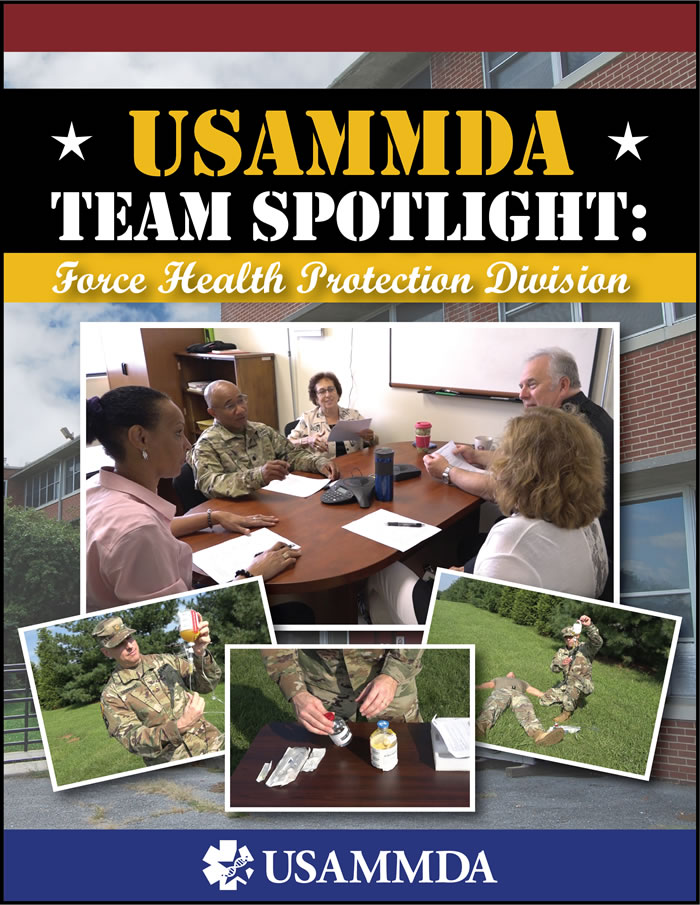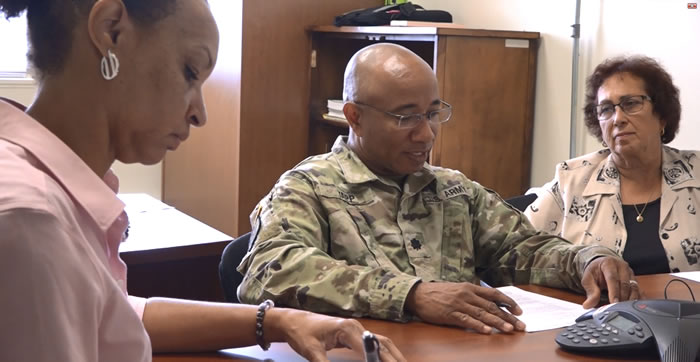USAMMDA Team Spotlight: Force Health Protection Division

The Force Health Protection Division within the U.S. Army Medical Materiel Development Activity, Fort Detrick, Maryland, is charged with providing our nation's military forces with medical countermeasures and treatments that are not necessarily licensed in the U.S., due to the often unique circumstances of the targeted disease or illness. As a subordinate command of the U.S. Army Medical Research and Materiel Command, USAMMDA's primary mission is to develop and deliver quality medical capabilities to protect, treat and sustain the health of Service Members throughout the world, and the organization's FHP team helps to ensure this task is met. Recently, the USAMMDA public affairs office met with FHP senior product manager/senior scientist Dr. James Karaszkiewicz to discuss the current and future projects of the group. Karaszkiewicz provided a thorough overview and offered insight on the critical work of the FHP office.
PAO: In a nutshell, please explain the FHP Division.
JK: FHP is focused on maintaining and providing lifesaving medical products that are not currently available on the commercial market. We make products available to the Warfighter, and in some cases dependents, prior to their licensure as part of FHP programs. But all of this is done under appropriate U.S. Food and Drug Administration regulatory mechanisms.
PAO: What are FHP's current products?
JK: Many of our products are "insurance policies," if you will. We have a number of products that are intended for the treatment of biological or chemical warfare agents. We have Service members deployed globally that could be exposed to these threats, and so we have products positioned forward in case they are needed to save lives. Hopefully, we'll never have to use these for this purpose. We have other products for endemic diseases. For example, ribavirin is used for the treatment of hemorrhagic fever with renal syndrome, and some other hemorrhagic fever viruses for which there are no FDA-approved treatments. We have products for leishmaniasis, both systemic and cutaneous, and we have other products that we've used, such as an oral antiviral for orthopox (smallpox and related viruses) was recently approved for treating smallpox. We have used this successfully to treat systemic infections resulting as a reaction to the smallpox vaccination.
We actually have 11 products that we manage, although most we don't use routinely. It takes a long time for these to move through the life cycle process for development and fielding. Product development for medical products is a long-term process, in general. In some of these cases related to our products, they are rare diseases that don't occur very readily in the U.S., although they may occur naturally around the world. So, enlisting enough patients in a clinical trial might take a fair amount of time. Therefore, the mechanisms that are available from the FDA, which are Expanded Access Protocols and Emergency Use Authorizations, provide a means within the FDA regulatory environment to make certain products available for use prior to licensure.

PAO: On the development pipeline, where does FHP fall?
JK: Somewhere past the halfway point. The ideal place for an FHP product in a protocol is after Phase 2 clinical trials, where they still have to complete a Phase 3 trial and the New Drug Application or Biologics License Application submission. But there are circumstances where, if nothing else is available, the FDA is willing to look at the product if it has a good safety profile with a potential for benefit, and they may accept a protocol. Or there might be an emergency situation, where that kind of product might be acceptable with minimal demonstration of efficacy, as long as it has a good safety profile. A lot of this depends on the risk-benefit analysis that the FDA will do, because if the condition you're trying to treat is sufficiently dangerous, then the FDA may be willing to accept a little bit more uncertainty for the product, and they may impose some additional constraints on how it is used.
PAO: What is FHP's overall mission and goal?
JK: Our main focus is to try and make these particular products available, because they may never be licensed in the U.S. by the FDA. Intravenous ribavirin, which we've actually used once or twice, is a good example. There are diseases that just don't occur in the U.S., so no one is going to make the investment to try and gain approval in the U.S. for that particular indication. It is approved for some diseases, but not for others in the U.S. So, there is no point in spending the money if there is no market for the product.
PAO: What are the responsibilities of an FHP product manager?
JK: We maintain the inventory of products. We have them stored locally, in some cases. In other cases, we have them positioned in Europe or in Asia, because they may be needed in locations closer to those areas, and they can be shipped more quickly from there. If time is of the essence in order to get this treatment to someone, we ensure that some of the product is closer to where it is likely to be needed. We write the protocols, and we manage the protocols. We are the primary interface with the USAMRMC Institutional Review Board. We work to amend protocols or develop any packages of information that are necessary; so we'll go out to conduct training at the sites and coordinate between these sites. Basically, we manage everything related to the product, from the development of the protocol through the logistics.
PAO: Please detail some of the most important points of FHP's work.
JK: FHP forms a bridge between the regulatory world and the product development world. The regulatory mechanisms that we use, and operate within, are niche areas within the regulatory environment. If you go out into industry, you'll find very few people who are familiar with Expanded Access Investigational New Drug applications or Emergency Use Authorizations, because these just don't come up for them. But within USAMMDA's FHP Division, it's the center of our world. We operate under Department of Defense Instruction 6200.02, which defines the use of unlicensed products for FHP programs. We have become experts in the regulatory niche, and we also have on our staff clinical experience, product development experience, scientific expertise as well as regulatory expertise – so we're somewhat self-contained in this respect. We also leverage expertise from other groups, especially from whomever is developing the particular product, because they are the initial expert until we become familiar with the product. We can serve to help them make the product available prior to its submission to the FDA for licensure or approval.
PAO: Are there any new products on the horizon?
JK: There are a couple of new efforts underway that are related to the passage of a new public law in December 2017 that allows the U.S. Secretary of Defense to declare a health-related emergency, or imminent emergency, for military combat-related situations. Prior to this, Emergency Declarations or Emergency Use Authorizations were limited to chemical-, biological- or nuclear-type events, and this had to be declared by the U.S. Secretary of Health and Human Services. So, this has changed, and there are now a number of projects with which FHP is involved, that address some of those issues. One of the most recent is the issuance of an EUA in July 2018 for the use of French freeze-dried plasma. We did have protocols in place for this, but the EUA anticipates that the use of this may increase, so it reduces/relaxes some of the requirements for documentation that exist when you have an Expanded Access protocol in place.
PAO: How do you feel about your work, and the work of the FHP team?
JK: It's very important! Sometimes it may seem that our group does not have much going on, because a great deal of what we do involves administration, such as managing documentation in the regulatory environment. But it's very important work because, as I've said, we're the only operational division at USAMMDA. I came from a product development environment, and I developed diagnostics for nine years before coming here. The product was an FDA-cleared diagnostic for biological warfare agents. We did all of the work, and it received FDA clearance, but the system was never used. Now, that's not necessarily a bad thing given what the product was for, but there certainly is an amount of gratification in seeing the product you're managing actually being used – and in our case at FHP, to see it saving lives! Most of our products are for life-threatening conditions, and we can document a number of cases where lives were saved because we were able to make a critical product available. That's what we're here for – to support the Warfighter! Although these diseases may be rare, the consequences are still very serious. As in a chemical/biological attack, the probability may be low, but the consequences are very high. So, having a team in place to respond to this is very important, and it is personally gratifying as well.













